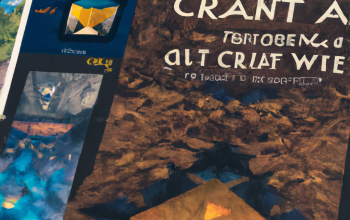Unleashing our imagination and stepping into mesmerizing worlds teeming with extraordinary characters is an undeniable allure of the gaming universe. From fantastical realms to dystopian landscapes, every pixel and brush stroke beckon players to embark on awe-inspiring adventures. Game aesthetics serve as the enchanting secret behind these virtual realms, forming the crux of our immersive experiences. In this article, we embark on a journey to unravel the mysteries of character design, world-building, and visual styles, delving into the depths of game aesthetics and discovering the magic that lies within. So, grab your controller, ready your imagination, and prepare to be captivated by the wondrous sights that await as we explore the artistry that brings our favorite games to life.
The Enigmatic Art of Character Design: Unveiling Intricate Layers and Crucial Elements
The Enigmatic Art of Character Design
Character design is an awe-inspiring art form that goes far beyond mere visual representation. It breathes life into imaginary beings, unveiling intricate layers and crucial elements that resonate deeply with audiences. Within the realm of character design, artists immerse themselves in a world where every line, every contour, and every color choice holds purpose and meaning.
At its core, character design is a captivating blend of creativity, psychology, and storytelling. It is a dance between the artist’s imagination and the emotions they wish to evoke in the viewer. Crucial elements such as facial expressions, body language, and even color palettes come together harmoniously, revealing the essence of a character and their journey. Each design decision contributes to the overall narrative, offering subtle hints about a character’s personality, motives, and background.
- Purposeful Design: A character’s visual features are meticulously crafted to align with their role in a story. Every facial expression, gesture, and outfit choice is a deliberate part of their unique identity.
- Emotional Connection: The success of character design lies in its ability to make the audience feel, to elicit genuine emotions. Strong character design transcends the boundaries of paper or screen and leaves an indelible mark on our hearts and minds.
- Symbolism and Metaphor: Character design often incorporates symbolism and metaphor, expressing deeper layers of meaning that enrich the narrative. Colors, accessories, and even small details play a pivotal role in conveying these hidden messages.
- Evolution and Growth: Characters are not static entities but vessels for personal growth and development. Successful character design captures this journey, allowing the audience to witness their transformation and connect with their struggles and triumphs.
Ultimately, the enigmatic art of character design wields the power to shape our perception and elevate stories to new heights. Through its intricate layers and crucial elements, character design serves as a visual language that transcends words, taking us on unforgettable journeys and touching our souls.

Delving into the Depths of World-Building: Crafting Immersive and Captivating Virtual Realms
Welcome, fellow adventurers, to the realm of world-building, where imagination knows no boundaries! In this mystical journey, we shall embark on a quest to uncover the secrets behind crafting virtual realms that transport our senses to unimaginable heights. To create a truly immersive experience, one must start with a strong foundation, breathing life into the very essence of the world.
First, envision a captivating narrative that weaves through the fabric of your virtual realm. Unleash your creativity and let your story flourish, for it is the backbone upon which all other elements shall thrive. The characters that reside within this realm must be authentic, with intricate backstories that captivate and engage players on a deeper level. Fuel their imaginations by weaving their tales into the very fabric of the world, allowing their journeys to intersect in ways that bring depth and meaning to their interactions.
- Construct breathtaking landscapes that tantalize the eyes and awaken the wanderlust within every player. From ethereal floating islands to ancient ruins steeped in history, each environment must offer a sense of wonder and discovery. Use a mix of lush flora, grand architecture, and magical phenomena to create a visual feast for the senses.
- Enrich the tapestry of your world with unique cultures, diverse societies, and rich lore that echoes through the ages. Uncover the traditions, customs, and belief systems that shape the inhabitants’ daily lives, fostering a sense of realism and depth unparalleled in the virtual realm.
- Embed secrets and hidden treasures into every nook and cranny, rewarding persistent adventurers with a sense of accomplishment. Leave breadcrumbs of mystery, waiting to be unraveled, and watch as players become enthralled in the mystery and conspiracies that lurk within your creation.
So, brave souls, as you venture forth in your quest to breathe life into awe-inspiring virtual realms, remember that world-building is an art that requires equal parts skill and imagination. Harness them to craft immersive experiences that transport players to magical realms that stretch beyond the confines of their screens. The journey lies ahead, adventurers, awaiting your touch to shape the worlds of tomorrow.
Visual Styles: Unraveling the Power of Aesthetics in Game Design
Unleashing the Visual Magic: Discovering the Transformational Aesthetics of Game Design
In the realm of game design, visual styles serve as the gateway to captivating experiences and immersive storytelling. With the power to influence emotions, enhance gameplay mechanics, and transport players to vivid worlds, choosing the right visual style is a critical aspect that game developers must carefully consider. Through the skilful use of aesthetics, games can truly become works of art, evoking wonder and leaving an everlasting impression on the players’ minds.
1. Evoking Emotions: Visual styles hold the remarkable ability to evoke specific emotions within players. Whether it’s the vibrant colors of a cartoonish world that elicit happiness or the dark, eerie atmosphere that sends shivers down our spines, aesthetics can be game-changers in creating a mood that resonates deeply. By aligning the visual elements with the intended emotions, game designers can craft a more immersive and engaging experience that connects players to the game’s narrative in an unparalleled way.
2. Enhancing Gameplay: Visual styles also play a crucial role in reinforcing gameplay mechanics. From the pixelated nostalgia of retro games that seamlessly integrate with simplistic controls to futuristic, high-tech environments that amplify the adrenaline-fueled action, aesthetics can enhance the overall gameplay experience. By harmoniously blending aesthetics and mechanics, game designers can create a cohesive and rewarding flow that not only captivates players visually but also deepens their interaction with the game world, making it a truly unforgettable journey.
Navigating the Maze: Recommendations for Mastering Game Aesthetics
If you aspire to become a master of game aesthetics, it’s crucial to immerse yourself in the captivating world of visual design, soundscapes, and storytelling. These essential elements work harmoniously to create a truly unforgettable gaming experience. To assist you on your journey to mastering game aesthetics, we’ve compiled some recommendations that will help you navigate the intricate maze of creativity and bring your game to life.
First and foremost, embrace the power of color. A well-thought-out color scheme can set the mood, evoke emotions, and enhance gameplay. Experiment with bold and vibrant hues to create eye-catching visuals or opt for a more subdued palette to evoke a sense of tranquility. Remember, consistency is key! Ensure your chosen colors align with your game’s theme and story.
Similarly, the implementation of immersive sound design can elevate your game’s aesthetics to new heights. Delve into the world of ambient sounds, sound effects, and music that seamlessly blend with the gameplay. Pay attention to the details – the gentle rustling of leaves, the distant echoes of footsteps, or the crescendo of an epic battle theme – all of these elements contribute to the overall immersive experience for players.
Insights and Conclusions
In the kaleidoscope of game aesthetics, where the boundaries of imagination are pushed and artistic worlds are brought to life, we have embarked on a fascinating journey. Throughout this article, we have delved deep into the mysteries of character design, world-building, and visual styles, unraveling the intricate threads that bind these elements together in the realm of gaming.
From the ethereal beauty of ethereal beings to the gritty realism of post-apocalyptic wastelands, character design captures the essences of our virtual companions. It is an artistry that breathes life into pixels, transforming mere lines and polygons into iconic figures that resonate with our emotions. Their faces, their forms, and their stories become etched into our memories, forging an everlasting connection between player and avatar.
As we have uncharted the paths of world-building, we have witnessed realms that defy reality and stretch the limits of our imagination. Whether it be fantastical landscapes ripe with mysticism or modern cities pulsating with technological marvels, these virtual worlds are the canvas upon which authenticity and believability merge. The careful attention to detail in architecture, flora and fauna, and dynamic environmental conditions elevates gameplay to new heights, keeping us enthralled within vast realms that beckon us to explore.
Now, let us plunge into the realm of visual styles and indulge in the diverse artistic expressions that gaming offers. From the beguiling strokes of cel-shading to the enchanting allure of pixel art, visual styles paint the narrative of a game. Each stroke, each color, and each texture are woven together with meticulous care, giving birth to universes that are as captivating as they are visually exquisite. It is through these artistic choices that game developers manifest their boundless creativity, offering players a sensorial experience like no other.
As we draw the curtains on this journey into the secrets of game aesthetics, we are left with a profound appreciation for the masterminds behind the magic. Character designers, world-builders, and visual artists play the roles of digital sorcerers, casting spells that transport us to fantastical realms. They create spaces and characters that transcend the confines of reality, granting us an escape into parallel worlds that captivate our souls.
So, let us continue to celebrate the mysteries of character design, world-building, and visual styles, for they breathe life into our gaming experiences. As players, we become adventurers, explorers of immersive landscapes and characters that leave an indelible mark on our minds and hearts. Embrace the enchantment that game aesthetics offer, and may your gaming endeavors forever be illuminated by the splendor of their artistic allure.
The modern video game is a complex matrix of elements that come together to form a unique art form, a fusion of visuals, narrative, and interactivity merged to captivate the player’s imagination and provide a lasting experience. One of the most integral components in crafting a successful game experience is the aesthetic design of the game, which includes character design, world-building, and visual styles.
Character design is an incredibly important element in any video game. Each character must have their own unique style and tone that fits the narrative and world of the game. By utilizing a variety of complex visual cues, the game designer is able to effectively create a character whose purpose stands out from the rest of the game’s inhabitants. Through the intentional use of color, shape, and form, the character draws the players attention and can create a lasting impression.
World-building is another key component in aesthetic design. It can include everything from the overall theme of the game to the geographic layout of the world. Players appreciate when the game world is immersive and expansive. It gives them room to explore and interpret the game in their own way. By giving careful consideration to the specific details of the world, such as the environment, architecture, flora, fauna, and technology, the game designer can ensure that the game succeeds in creating a compelling experience for the players.
The visual style of the game is the finishing touch on the aesthetic design of the game. By cleverly implementing textures, lighting, shadows, and other elements of design, the game designer has the power to tie the other game elements together and create a cohesive world. A great visual style is a necessary component for a successful game. It can be used to enhance the narrative and create visually appealing moments that captivate the player.
In short, exploring game aesthetics is a critical part of the process of making successful video games. By carefully considering the characters, world, and visual style of the game, the game designer is able to craft an individual and successful experience for the players. With the careful use of game aesthetics, the player is taken on a journey through an immersive and captivating world.



